|
| |
Remembering Tubbs! - The Music of Tubby Hayes
- Birth Name:
Edward Brian Hayes
- Birth place - Raynes
Park, South Wimbledon 30/01/35
- Active: '50s,
'60s, '70s
- Instruments:
Vibraphone, Sax (Tenor), Flute
Biography
One of Britain's top jazz musicians of the 1950s
and '60s, Tubby Hayes was a fine hard bop stylist on tenor and occasionally
vibes and flute. A professional at 15, Hayes played with
Kenny Baker and in the big bands of
Ambrose,
Vic Lewis, and Jack Parnell during 1951-1955. He led his own group after
that, and started doubling on vibes in 1956. Hayes co-led the Jazz Couriers with
Ronnie Scott (1957-1959), and appeared in the U.S. a few times during
1961-1965. He headed his own big band in London, sat in with
Duke Ellington's Orchestra in 1964, and was featured at many European
festivals. Heart trouble forced him out of action during 1969-1971, and caused
his premature death. Tubby Hayes led sessions for Tempo (1955-1959), London,
Jazzland (1959), Fontana, Epic (a 1961 date with
Clark Terry and
Horace Parlan), Smash (a 1962 album which matched him with
James Moody and
Roland Kirk), 77, Spotlite, and Mole. ~ Scott Yanow, All Music Guide.
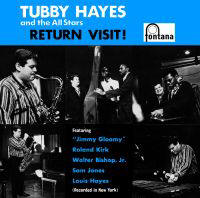 Personnel
- "Return Visit!" showcases Tubbs on tenor saxophone and vibes along with
'Jimmy Gloomy' (James Moody) on tenor and flute, and multi-instrumentalist
Roland Kirk playing tenor, flute, nose flute, manzello and stritch. Accompanied
by a rhythm section of pianist Walter Bishop Jr, bassist Sam Jones and Louis
Hayes on drums. Personnel
- "Return Visit!" showcases Tubbs on tenor saxophone and vibes along with
'Jimmy Gloomy' (James Moody) on tenor and flute, and multi-instrumentalist
Roland Kirk playing tenor, flute, nose flute, manzello and stritch. Accompanied
by a rhythm section of pianist Walter Bishop Jr, bassist Sam Jones and Louis
Hayes on drums.
Recorded in New York on June 23, 1962.Tracks -
Aftenoon in Paris
I See With My Third "I"
Lady "E"
Stitt's Tune
MEDLEY:
If I Had You
Alone Together
For Heavens Sake
Tubby Hayes was born and brought up in
Raynes Park,
London. His father was a
BBC
studio violinist who gave his son
Violin lessons from an early age. By the age of ten Hayes
was playing the
Piano
and started on the Tenor Sax at eleven. One much repeated
story about Hayes' early career was told by
Ronnie Scott. Scott was playing at a club near Kingston, and
was asked if he minded if a local player sat in: "This little
boy came up, not much bigger than his tenor sax. Rather
patronisingly I suggested a number and off he went. He scared me
to death." After a period spent playing with various
semi-professional bands around London, Hayes left school and
started playing professionally at the age of fifteen.
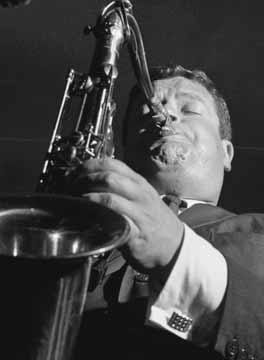 His
major recognition came on the BBC Jazz Club shows of December 18th 1968 and
April 9th 1969. His
major recognition came on the BBC Jazz Club shows of December 18th 1968 and
April 9th 1969.
The first was the radio "debut" of Tubby's new quartet with Louis Stewart, Ron
Mathewson and Spike Wells, and on the programme they appeared opposite the Joe
Harriott quintet comprising Joe, Kenny Wheeler, Pat Smythe, Ron Mathewson
(again!) and Bill Eyden, who played a wonderfully mixed repertoire by Kenny
Wheeler, Ornette Coleman, Horace Silver and Joe himself.
Tubby had formed the quartet with Louis in late summer 1968, after the famous
"Mexican Green" line-up of Mike Pyne, Ron Mathewson and Tony Levin had
disintegrated following Tubby's drug-related period of seclusion. In fact,
hearing that Hayes was looking for a guitarist, Stewart, who'd barely been in
London a few weeks, decided to introduce himself to Tubby;
"It was all very casual at first" he told writer Tony Wilson shortly
afterwards, Tubby said it was the kind of thing he was looking for. Initially
we rehearsed a lot. some of Tubby's compositions are quite unusual...there are
some fast tempos that I haven't experienced. If Tubby wants to keep me, I'll be
happy".
Tubby was indeed very satisfied with Stewart, as he wrote later that year;"he
handles the difficult 'comping' role unobtrusively and with taste in the absence
of a piano in the quartet. In this role he follows Terry Shannon, Gordon Beck
and Mike Pyne, and when I say I do not miss the piano, it is meant as the
highest compliment".

Newpaper advertisment for the Wood Green Jazz Club @
The Fishmongers Arms, Wood Green, London with blatant mispelling of Louis
Stewart's name in the Royal 'Manor' - probably phoned in.
more back
ground on the Bourne Hall / Wood Green / Fishmongers Arms Jazz Club from
contributors to
Sandy Brown Jazz
Also on
Paul Vernon Chester Website
However, Tubbs was experiencing less immediate results in securing the bass and
drum chairs of the new group. Initially he opted for the "safe bets" of former
Jazz Couriers Phil Bates and Bill Eyden before Ron Mathewson and Tony Levin
returned for what was in Levin's case a second brief stint with Tubby.
When the quartet made its public debut at Ronnie Scott's in November 1968
(opposite none other than T-Bone Walker!) Tony Oxley was behind the kit. It was
to be Ron Mathewson who finally settled Tubby's worries about a suitable drummer
when he suggested Tubbs hear the 22 year old student living in the downstairs
flat at the famous 80 Sinclair Road, West Kensington, (home to not only
Mathewson but Chris and Mike Pyne and Ray Warleigh); Spike Wells.
Late in the autumn of 1968, Mathewson arranged an "audition" for Wells to be
held at Sinclair Road. "I just had a short time to get my head around the
fact I was having the opportunity to join the leading jazz group in the country.
I wood shedded a lot, particularly on fast tempos, which was the one thing I
knew he would be merciless about", Wells told me recently.
Spike's worries were needless, as the audition got no further than the second
number before Tubby turned to him and promptly offered him the job!
The quartet with Stewart, Mathewson and Wells lasted until July 1969, when
Stewart left the group following the legendary "aborted" Fontana sessions,
ceding once more to Mike Pyne. Stewart would remain an integral part of Tubby's
big band until the autumn of 1969.
The two surviving BBC Jazz Club performances are classic post-"Mexican Green"
Tubby. Whereas compositions such as Blues In Orbit on Mexican Green more
than hinted at Tubby's fascination with Coltrane, the spacious possibilities of
the group with Stewart, identical in instrumentation to Sonny Rollins "Bridge"
quartet, drew out Tubby's more melodic and rhythmic side. His version of Luiz
Bonfa's bossa nova The Gentle Rain is a flute tour de force which ranges
from lyricism to a gorgeous percussive unaccompanied chorus. Jimmy Heath's
Gingerbread Boy is another first class example of Tubbs flute work, whilst
the breadth of his tenor skills is illustrated on the killer breakneck tempo of
Oleo and the singing Getz-like ballad reading of Lalo Schifrin's The
Right To Love.
Tubby's interest in the avant garde is present in the admittedly rather mannered
"freak out" section of his own composition The Inner Splurge and the
rock-based Song For A Sad Lady (written for Joy Marshall) which was to
become a staple part of Hayes 1969 repertoire both with the big band and the
quartet, gives an indication of his nods towards popular music.
Perhaps the BBC sessions most intriguing piece is Rumpus, one of Tubby's
own themes which gives early indication of his fascination with whole-tone
harmony. Other "late" Hayes compositions such as Sienna Red and Lady
Celia contained sections based on whole-tone modes, something Tubby may well
have gleaned from his interest in the work of Joe Henderson.
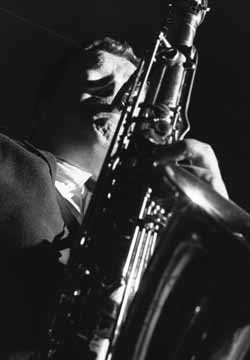 Spike
Wells recalls how during his time with the Hayes quartet, Tubby virtually wore
out his copies of Henderson's classic Blue Note LPs. This point is worth
expanding upon; the language of John Coltrane, whilst indisputably something
about which Tubby was both enthusiastic and curious, was not his natural musical
environment. Tubby's latter day enthusiasm for Joe Henderson and Booker Ervin
reveals much about his thinking. Both these players trod a very personal middle
ground between the dominating twin influences of Trane and Rollins, something
which I think Tubbs saw as practically useful. Spike
Wells recalls how during his time with the Hayes quartet, Tubby virtually wore
out his copies of Henderson's classic Blue Note LPs. This point is worth
expanding upon; the language of John Coltrane, whilst indisputably something
about which Tubby was both enthusiastic and curious, was not his natural musical
environment. Tubby's latter day enthusiasm for Joe Henderson and Booker Ervin
reveals much about his thinking. Both these players trod a very personal middle
ground between the dominating twin influences of Trane and Rollins, something
which I think Tubbs saw as practically useful.
Again, for me this is one of Tubby's most endearing musical traits, that he
could and did throughout his career synthesise elements from the finest
saxophone influences (Trane, Rollins, Griffin, Getz, Mobley, Zoot, Joe
Henderson) and come up with something which was so instantly recognisable as his
own.
I can think of few saxophonists apprenticed in the musical environment Tubbs
grew up into who could so masterfully manage the extremes that his music
touches, from Mexican Geen to the tightest hard bop of the Jazz Couriers to
stunningly lyrical balladry. Indeed, when you pause to think of Tubby's
achievements and stylistic evolution in what was a brief career you see the same
characteristic interlinking thread of energy and commitment encountered in John
Coltrane's musical journey.
Tubby may not have changed the musical landscape in the way that Trane did, but
I continue to believe that there is something profound in his story which
transcends his super proficiency, technical dexterity and the surface gloss and
which goes far deeper. Consider the equation of opportunity and environment
which was the background to Tubby Hayes career.
The certainty and confidence he always possessed retain the power to move and
inspire today. What better legacy could any jazz musician
leave?.......................Simon Spillett
More from Simon.....
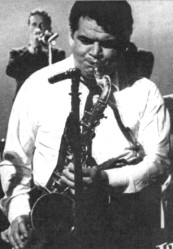 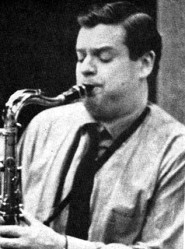 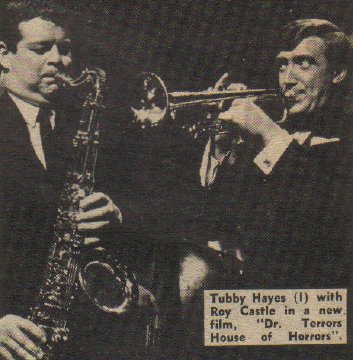
My research has shown that
during his hey day barely a month went by without Tubby appearing on a BBC
jazz broadcast.
1969 was clearly a purple patch with Tubby's big band and quartet appearing
on the Jazz Club, Jazz Workshop and then new Jazz In Britain
series.
The quartet featuring Mike Pyne, Ron Mathewson and Spike Wells actually
recorded the very first installment of the latter on Friday September 26th
(broadcast on October 22nd 1969). Amazingly, Spike Wells recalls that the
session, held at BBC Maida Vale studios, started at 9 a.m!
One track from this set, the Hayes flute version of Mike Pyne's devilishly
complex A Uttoxeter Idyll was broadcast on the BBC Jazz Legends
episode devoted to Tubby in 2001.
Part of the Hayes big band's July 1969 Jazz Workshop session found
its way onto CD in 1992 as 200% Proof. The big band and both editions
of Tubbys' quartet (featuring Louis Stewart or Mike Pyne) made no less than
five other appearances on Jazz Club that year. Three items from the
August 6th Jazz Club broadcast were issued as CD only bonus tracks of
the Harlequin album Live 1969.
The above effectively encapsulates Tubby's jazz work on radio during this
period, however it isn't widely known that from autumn 1968 Tubby made
regular appearances in a rather more commercial vein on Radio One's Late
Night Extra.
As a featured member of the David Francis Tentette (and billed as such in
the Radio Times) Tubby joined a series of mouth wateringly bizarre
programme line-ups for a show which, as the Beeb itself put it, promised
"music and news; pop; people and places".
Broadcast between ten and midnight on weekdays, the programme was introduced
by Terry Wogan (!) or Bob Holness (who once revealed that the first time he
saw Tubby was at the old Studio 51 club, sitting on the stage, his feet
dangling and a borrowed baritone clamped between his jaws). The Francis
Tentette might find itself sharing the bill with guest big bands such as
Edmundo Ros or the Radio Big Band and vocalists such as Danny Street and
Rosemary Squires. One wonder if any of these survive?
Tubby's association with David Francis was ongoing up until his death in
June 1973. Indeed one of Tubby's final big concert appearances was at The
Fairfield Hall, Croydon on Friday March 9th 1973 with David Francis and the
Sound of Strings. Billed as "a programme of Film and Show music", the
concert programme lists such disparate musical treats as a Wild West Medley,
and the themes from The Onedin Line and Shaft!
Tucked away towards the end of the night was a version of Moon River
featuring Tubby.
The evening prior to the Croydon concert, Tubby had played what would
transpire to be among the last half dozen or so gigs he would perform with
his quartet. Tubby, Mike Pyne, Ron Mathewson and Spike Wells had travelled
to Southend at the behest of former Flamingo compere Bix Curtis (the man to
whom Tubby had dedicated his composition The Serpent....use your
imagination!) who was then promoting weekly jazz events at a noisy pub named
the Top Alex in Alexandra Street.
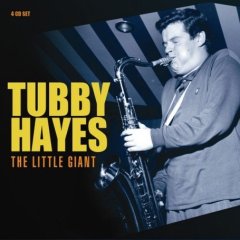 Tubby
and pianist Tony Lee had already played a session at the venue on Sunday
February 4th (accompanied by bassist John Moule and avant-garde drummer
Trevor Taylor, who nowadays runs the FMR record label and the Soundworld
publishing company) but for the March 8th gig Hayes and the quartet appeared
opposite the local Kenny Baxter Jazztet (fronted by saxophonist Baxter,
still a fixture on the jazz scene in Kent I understand) and, as special
guests, trombonist John Picard and tenorist Kathy Stobart. Tubby
and pianist Tony Lee had already played a session at the venue on Sunday
February 4th (accompanied by bassist John Moule and avant-garde drummer
Trevor Taylor, who nowadays runs the FMR record label and the Soundworld
publishing company) but for the March 8th gig Hayes and the quartet appeared
opposite the local Kenny Baxter Jazztet (fronted by saxophonist Baxter,
still a fixture on the jazz scene in Kent I understand) and, as special
guests, trombonist John Picard and tenorist Kathy Stobart.
The final jam session had the Hayes rhythm team accompanying Baxter, Picard,
Stobart, Tubby and tenorist Gary Windo, who Tubby had become friendly with
during his last year.
It would be Windo who would drive the Hayes quartet to its ill-fated final
gig in Brighton on Saturday May 12th 1973, and who would have the unenviable
task of replacing Tubby at the last minute when he became too breathless to
play.
The Southend gig had a delightful moment when Tubby's patience snapped, as
Spike Wells recalled. Irritated by Bix Curtis repeatedly disrupting the
evening in order to remind patrons that food was available, Tubby grabbed
the microphone and said "Ladies and gentleman, just a brief interruption
to tell you that the specialities of the house are filth omelette and vomit
pie and chips!"
I witnessed a performance
by Tubbs in the Abergeldie Jazz Club in Aberdeen circa 1961 with Tubbs on
Tenor & Vibes and now forgotten bass & very crisp Drums. Tubby displayed a
blistering delivery with his phenomenal technique and interspersed with his
wonderful touch on Vibes an element of his playing which is oft ignored -
see below. When implored by a modern jazz starved audience to do one
more encore Tubby counted in a long but impossibly fast tempo - he blew one
note on his tenor and .............said Goodnight!
Another story was of the
Reading Jazz Festival when he stepped forward for his solo and in taking a
large gulp of air for his intended attack he ingested one of the moths
attracted by the spotlights and caused some consternation among fellow
musicians as to how to fill those silent bars with sound as Tubbs coughed up
and away the dusty mite from the back of his capacious tubes.
Jazz-Eddie
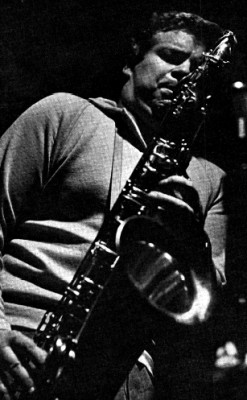 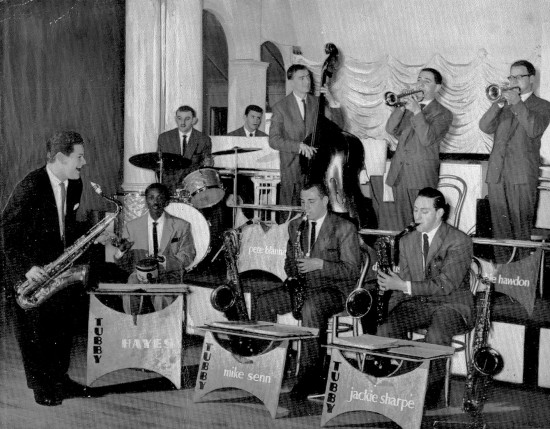
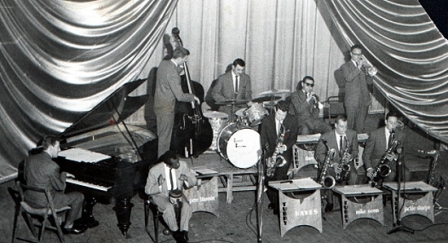
interesting music stands - who designed them - audience friendly, but are
they practical for musos?
Tubby's first band started at Southsea Pier on April 1st (prophetic) 1955,
and struggled on until October 1956.
The original personnel in the photo was Harry South (piano), Pete Blannin
(bass), Lennie Breslow (drums), Dave Usden, Dickie Hawdon (Tpts), Tubby &
Jack Sharpe (tenors) and Mike Senn on alto. Bobbie Breen was singer & conga
drum. Later Dave Usden was replaced by Ian Hamer. Lennie Breslow by Bill
Eyden.
Jazz Eddie - Bobby Breen (was the name borrowed from the American Child
singer/actor) also sang with the Dankworth band and had a very
pronounced but endearing lisp - this gave a new slant with his enunciation and
interpretation of Route 66 - as written by Bobby Troup - Jazz Pianist who
was later married to Julie London and mastered her hit "Cry me a River"
Jimmy Deuchar -Tubby Hayes - Suddenly Last Tuesday
Interview
with Tubby Hayes
Tubby
Hayes - Sal Nistico Exchange
Excerpt about his Vibraphone
NISTICO: I’m told you play
excellent vibes, Tubby. I never heard you.
HAYES: I used to play ‘em a lot. I don’t play ‘em very much these days.
NISTICO: How’d you get into that?
HAYES: Through Victor Feldman. When he was with Woody Herman - he came over
here for a holiday, or something. It’s about ten years ago now. And we were
working together in a club in town. I used to stand there behind him,
listening all the time - and I fancied playing ‘em. So when he went back to
the States, I bought the instrument off him, that he was using, and I
started playing. But I just found that I didn’t have enough time. I’d go on
a gig and by the time I’d set the vibraphone up, plugged it in and got about
a 240–volt shock all up my arm - my hands are covered in grease, I’m
sweating - then I’ve got to get the tenor out, and we’re on! Then I’m
exhausted In the end it got to the stage where I used to set the bloody
thing up - play the tenor all night! Then pack it all away again. I said:
‘What am I doing?’
And now’, said Tubby, ‘we’re
going to play a number called I’ve Thrown a Custard in her Face, from
My Fair Lady. We’re a bit Mozart, and there are some dodgy Norwegians in
there, but we’ll do our best.’
Norwegian Fjords were
chords
Danny Kaye's hit Orchestral
Music saga 'Tubby the Tuba' may have been responsible for Edward Brian's
Hayes endearing but affectionate adopted or imposed nickname.
...............................Oh! - said Tubby - I am so happy!
We certainly are Tubbs -
Thanks!!
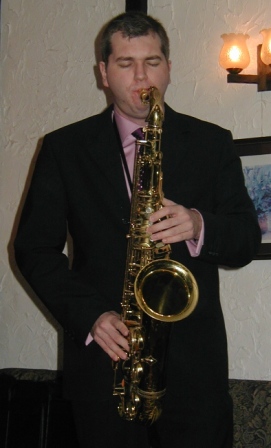 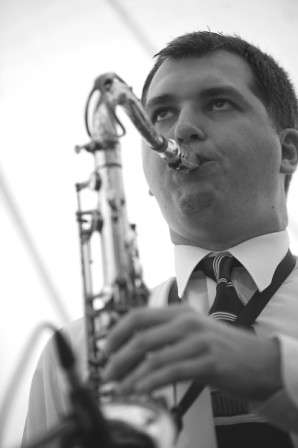  Simon
Spillett Profile of Tubby Hayes Simon
Spillett Profile of Tubby Hayes
Simon Spillett Website
Remember Tubbs
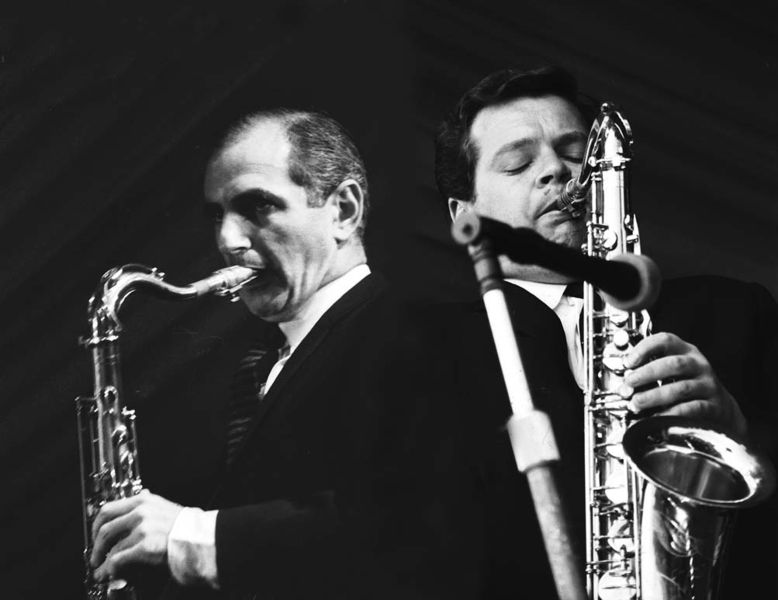
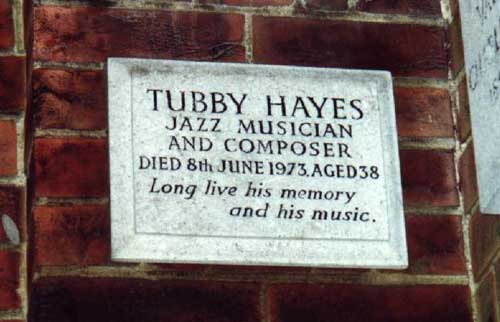 Matters
were made worse for Hayes by his development of a drugs habit, which came to
badly affect his health. In the late 1960s he underwent
open heart surgery he was able to start
performing again in 1971 (though he had more heart surgery that same year),
and in 1972 toured Scandinavia. on 8th June 1973 he died during another
heart operation, at the age of thirty-eight. Matters
were made worse for Hayes by his development of a drugs habit, which came to
badly affect his health. In the late 1960s he underwent
open heart surgery he was able to start
performing again in 1971 (though he had more heart surgery that same year),
and in 1972 toured Scandinavia. on 8th June 1973 he died during another
heart operation, at the age of thirty-eight.
Tubby Hayes was cremated at Golders Green Crematorium as later was fellow
Jazz Courier Ronnie
Scott. Tubby's ashes were scattered in Section 1-L .............a
suitably fertile zone.
The early death of a musician
at the peak of popularity often leads to legendary status as we reflect on the magic of the
performances we have witnessed or heard and we mourn the great potential
that we have been robbed of by their untimely departure.
Hail to thee oh Tubbs! - Lest
we forget.................
Hi, I
would just like to say, great website, especially the article on
Remembering Tubbs as the former Flamingo Compere Bix Curtis (the man
to whom Tubby had dedicated his composition 'The Serpent') was my
grandfather. Regards Mark Curtis
Jazz
Professional - interesting anecdotal jazz site!
Tubbs with the Benny Golsen
UK Band
Tubbs -
Parisien Thoroughfare
Tubbs
on Flute - In the Night
Tubbs - Inner
Splurge
Tubbs
Big Band - Killers of W1
|